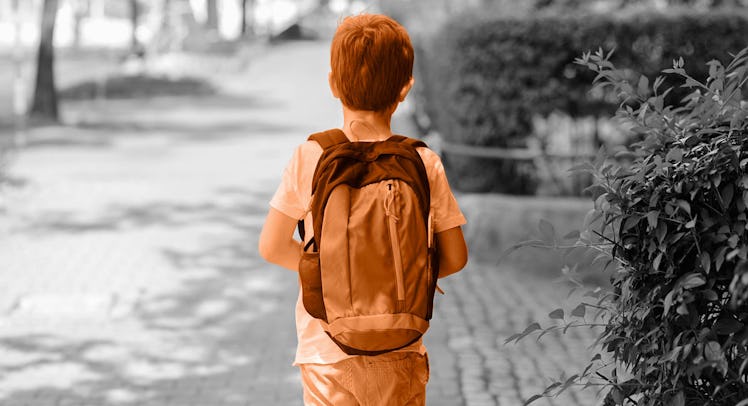When is a Kid Ready to Play Outside Alone and Unsupervised?
Kids are surprisingly capable and independent as long as parents are willing to take a step back.

For most caretakers, the doctrine of free-range parenting is intimidating. Allowing a kid outside alone can appear downright perilous. The media is always reporting stories about terrible crimes and it’s easy to get imaginative when pondering what might happen to kids allowed to roam the streets alone. It’s no wonder that there are so many helicopter parents in the world.
The reality, thankfully, is much less alarming. America has the lowest crime rate in decades — less than half of what it was in 1991 — and many current parents rode their bikes alone around their neighborhoods in the 1990s without the safety net of cellphones or GPS tracking devices. Parents need to recognize that—despite what our news feeds might indicate— children today are less likely to fall victim to some terrible act or accident than kids were a generation ago.
Crime stats aside, there are still some practical steps parents need to take to make sure their kids are ready for those first forays out into the big wide world. It’s all about smart preparation, trust, and empowering kids with the skills they need to get the hell out of potentially hazardous situations unharmed.
Four Ways to Prepare Your Kid to Leave the House by Themselves
- Act it out. Role play interactions with strangers, so your kid has some experience in avoiding and removing themselves from suspect situations should they arise.
- Pause on the tech. By all means, employ the entire digital arsenal to track your kid 24/7, but understand that eventually they will need to practice true independence without those safety nets.
- Build trust. Just because your child acts recklessly when you’re around to keep them safe, it doesn’t mean they aren’t capable of looking after themselves when needed.
- Enjoy the milestones. There is real pride in seeing your son or daughter go out and explore the world on their own.
“It’s your job as a parent to prepare your child to explore,” says Lenore Skenazy, founder and president of The Let Grow Project and author of Free-Range Kids: How to Raise Safe, Self-Reliant Children. “If you are going to let your kids out of your sight and have a modicum of the freedom you had as a child, then it requires training them to be independent.”
Skenazy speaks from experience. Her own son — somewhat controversially — took his first solo trips on the New York subway at 9-years-old.
Kids should feel confident before venturing out alone, but there might be some trepidation that manifests as fear… especially fear of strangers. A little bit of fear is a good thing in this regard, but it means having some pretty serious conversations about stranger danger that strike a balance between not compounding this fear with providing practical and useful guidance on how to act, what to do, and where to go if they feel uncomfortable.
Parents should focus on empowerment here, showing kids that it’s OK to say “no” to people they don’t know—even if it seems like it might be disrespectful or rude—and that there is a difference between strangers they can trust (such as police officers and moms with children) and strangers they should not go anywhere alone with. The key here is not to terrify. Show kids how they can bail from a situation if things get weird and show them where they can go for help if they need it. Role-playing helps, as it offers some rehearsal for potential real-life encounters.
There are, of course, plenty of digital solutions designed to allay fears by allowing parents to surveil their kids 24/7. There’s a lot of technology that lets parents track kids with satellites, from cell phone apps to GPS wearables. But this can be restrictive for both kids and parents because it doesn’t foster true independence. If anything, Skenazy says, these apps can cause parents more stress by placing the child’s responsibility solely on them—even when they aren’t together.
“You can control every step they take, count every step they take, you can geofence them,” Skenazy says, adding that such intense observation does nothing to build trust. Instead, allow kids more and more unsupervised time by increasing the time they are away from the fold incrementally.
Kids may seem like they need constant observation, but the secret is that even younger children are deceptively capable. Most parents will have experienced the white-hot terror of instinctively snatching a kid back from the road as they dart away from the safety of the family on the sidewalk and potentially into the path of a 16-wheeler. Does this mean certain death for that same child as they step out on their first adventure out of the house? Probably not, Skenazy says.
MORE: Can Parents Leave Kids Alone? For How Long? It’s All About Age.
“The only evidence we have that our children are maturing comes when we are with them,” Skenazy says, “but your child is always going to seem spacey and, to a certain extent, irresponsible when you’re with them. That’s because they’re with you. They know you aren’t going to let a car hit them.”
The more independence parents allow their children to have, the more independent those kids will become. There is no specific age that a kid is “ready” to go on their own adventures in the world, but with some planning and trust there is no reason a kid in 2018 should wait longer for those adventures than a kid from 1991 did.
“That’s the reason we’re here is to raise the next generation who will live on this earth when we die,” Skenazy says. “And you see the proof of that when you see your child do something on their own.”
This article was originally published on